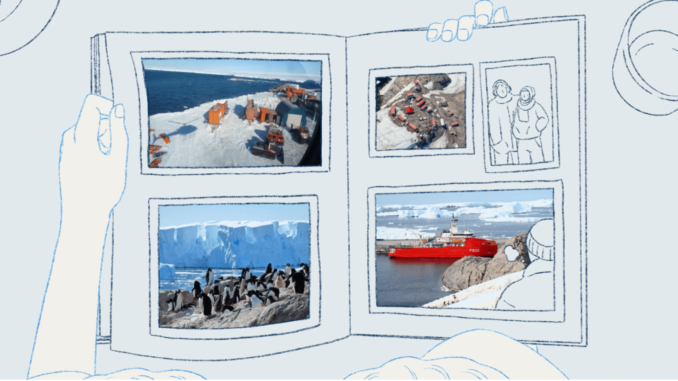
How can we show young people that the future is not set in stone and that they have a role to play in shaping it? This is the challenge taken on by PROTECT, a European research project, paired with an interactive digital game.
In May 2024, Venezuela’s last glacier disappears. Simultaneously, in Panama, the first climate refugees from Latin America leave ‘Crab Island’ to escape rising sea levels. In France, 500,000 homes are threatened by 2100.
These are facts that, in the eyes of young people, heighten concerns about the environmental crisis. Many feel it is ‘already too late to slow climate change before it causes devastating effects’ or feel powerless in the face of the climate struggle. How can we show them that the future is not set in stone and that they have a role to play?
This is the challenge taken up by PROTECT, a European research project, with the interactive digital initiative Sea Level Expedition, created by Clémence Foucher, a scientific illustrator.
Sea Level Expedition also aims to bridge two seemingly distant worlds: coastal regions and glaciers and ice caps. What connection exists between these two environments? Why does the disappearance of glaciers lead to rising sea levels? What mechanisms underlie these phenomena, and what role do human activities play?
A story where you are the hero
According to a survey conducted in 2022 with 72 middle school students, four activities dominate their free time: watching a series, spending time with friends, playing video games, and spending time with family.
Expedition Sea Level addresses these interests by offering a chapter-based activity (like a series), collaborative (to be done in groups), and interactive (like a video game), while telling the story of a family (like a shared moment).
The activity unfolds in three chapters, structured like a play.
In the first chapter, presented in a video format, we find ourselves in 2081 in the Maldives, facing a scenario of significant warming (+3.3-5.7 °C compared to 1850-1900). Samira, a young Maldivian girl, visits her grandparents, who are experiencing their home being engulfed by rising waters. In the middle of a storm, her grandmother recounts her first mission to Antarctica in 2026.
The second chapter takes us back to 2026. Samira wakes up in her grandmother’s shoes at the French scientific base of Dumont D’Urville in Antarctica. On the Astrolabe Glacier, she discovers glacial processes and the loss of glacier mass through quizzes and interactive games, thereby understanding their contribution to sea-level rise.
In the third and final chapter, players must make life choices. Depending on their decisions, three possible futures emerge for 2081: a limited warming (+1–1.8 °C compared to 1850–1900), an intermediate warming (+2.1–3.5 °C), and a significant warming (+3.3–5.7 °C). This chapter highlights the impact of human activities on the climate and how they shape our future.
Informing without alarming
This activity offers a simple yet scientifically rigorous visual and narrative discourse. “I aimed to synthesize the message while allowing players to identify with the characters and immerse themselves in the story,” explains Clémence Foucher, scientific illustrator and creator of the activity. To achieve this, her work relies on real locations, where drawings simplify and highlight essential elements for understanding.

In the face of a topic that often causes anxiety, this activity moves away from alarmist narratives while remaining grounded in reality. The tone adopted is factual and scientific, without morality or judgment. Players embark on a scientific expedition that equips them with the tools to understand complex phenomena, such as in Chapter 2, which takes place on the Astrolabe Glacier.
The structure of the activity has also been designed to limit eco-anxiety. By starting the story within a scenario of significant climate warming, the audience has the opportunity to anchor themselves in a scientific reality, thereby reducing the imaginative elements that can quickly exacerbate feelings of catastrophe. They will then be tasked with reconstructing or avoiding this future by understanding the processes and mechanisms at play, on which they may or may not have an impact.
Thus, the goal is to transform anxiety, which can be paralyzing, into a driving force through learning.
A multiple choices story
Beef burger or veggie burger? Train or plane? Car or bike? These are choices that young people face throughout their lives, each having a direct impact on the climate. Through this series of decisions, we aim to raise awareness among youth about opportunities for change, without judgment.

Players explore three possible futures in Chapter 3. They must adapt to these climatic futures, where sea levels vary in height. Depending on the scenario, adaptation will be easier or more difficult, and sometimes relocating is the only option, as is already the case in the world’s most vulnerable regions.
The initiative Expedition Sea Level embodies the idea that the future is not fixed but shaped by our collective and individual actions. By equipping young people with the tools to understand the causes and consequences of rising sea levels, they are encouraged to become agents of change, armed with scientific knowledge.

This article is published as part of the Science Festival “Fête de la Science” (which takes place from October 4 to 14, 2024), in partnership with The Conversation France. This new edition focuses on the theme “ocean of knowledge.” You can find all the events in your region on the website Fetedelascience.fr.
This project has received funding from the European Union’s Horizon 2020 research and innovation programme under grant agreement No 869304. This material reflects only the author’s view and the European Commission is not responsible for any use that may be made of the information it contains.
Gaël Durand, Research Director at the CNRS (National Center for Scientific Research) at the Institute of Environmental Geosciences, University of Grenoble Alpes (UGA), and Anne Chapuis, CNRS Communications Officer at the Institute of Environmental Geosciences, University of Grenoble Alpes (UGA).
This article is republished from The Conversation under a Creative Commons license. Read the original article.

Leave a Reply